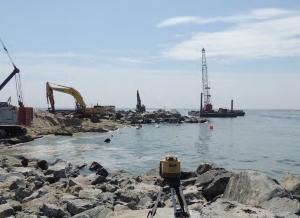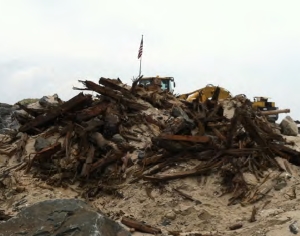Background & Cultural Resources Investigation
 A view of Barnegat Inlet North Jetty
In the summer of 2014, the U.S. Army Corps of Engineers, Philadelphia District commenced the process of repairing the Barnegat Inlet North Jetty, which was damaged during Hurricane Sandy. However, during repairs, which included removal of the existing damaged jetty, an apparent historic shipwreck was discovered after parts of it had been removed and piled onshore. Specifically, sections of hand-hewn, wooden hull fragments, treenails, and various metal fasteners were observed by the U.S. Army Corps of Engineers Quality Control officer and reported to Nicole Cooper Minnichbach, the U.S. Army Corps of Engineers Cultural Resources Specialist.
A view of Barnegat Inlet North Jetty
In the summer of 2014, the U.S. Army Corps of Engineers, Philadelphia District commenced the process of repairing the Barnegat Inlet North Jetty, which was damaged during Hurricane Sandy. However, during repairs, which included removal of the existing damaged jetty, an apparent historic shipwreck was discovered after parts of it had been removed and piled onshore. Specifically, sections of hand-hewn, wooden hull fragments, treenails, and various metal fasteners were observed by the U.S. Army Corps of Engineers Quality Control officer and reported to Nicole Cooper Minnichbach, the U.S. Army Corps of Engineers Cultural Resources Specialist.
The U.S. Army Corps of Engineers therefore determined that the shipwreck site was eligible for listing on the National Register of Historic Places under Criterion D, and that impacts sustained to the site resulting from construction activities constituted an Adverse Effect requiring mitigation. Subsequently, Panamerican Consultants, Inc. of Memphis, Tennessee was subcontracted to conduct mitigation that would entail archaeological monitoring of further jetty construction, assessment and documentation of debris already removed during construction, and systematic archaeological documentation and data recovery of the intact historic vessel, as well as archival research to identify the vessel and its history, if possible. Under subcontract to Tetra Tech, Inc., of Georgetown, Maryland, the mitigation investigation was conducted for the U.S. Army Corps of Engineers.
Conducted from 28 July to 20 August 2014, research, field observations, and wood analysis indicate the vessel was most likely a schooner barge built in the Northeast. Represented by a mostly buried in situ run of hull, a “debris pile” comprised of various ships timbers and several disarticulated components including stern deadwood, a rudder, and a windlass, the recovered material comes only from one side of the hull from about the deck down to and through the turn of the bilge. The remaining buried amount of hull is conjecture, but it is likely that at least half the hull to the keel is intact, and even the entire port side of the vessel could be present as well. Additionally, vessel material is associated with the presence of both iron knees and strapping.
 "Debris" pile showcasing timbers from the wreck
The use of these components indicates a construction date of the last quarter of the nineteenth century through the first quarter of the twentieth century. The vessel was most likely well over 100 feet, probably approaching 200 feet, as indicated by the large frame sizes and a hull side that is approximately 2 feet thick. The remaining in situ hull covers an area of at least 55 feet in length, and the removed intact hull components represent an additional 40 to 50 feet. The removed components did not contain any evidence of the bow, suggesting additional buried hull to the west of what was removed. While the identity of the North Jetty Shipwreck is uncertain, potential candidates have been determined.
"Debris" pile showcasing timbers from the wreck
The use of these components indicates a construction date of the last quarter of the nineteenth century through the first quarter of the twentieth century. The vessel was most likely well over 100 feet, probably approaching 200 feet, as indicated by the large frame sizes and a hull side that is approximately 2 feet thick. The remaining in situ hull covers an area of at least 55 feet in length, and the removed intact hull components represent an additional 40 to 50 feet. The removed components did not contain any evidence of the bow, suggesting additional buried hull to the west of what was removed. While the identity of the North Jetty Shipwreck is uncertain, potential candidates have been determined.
For more detailed information regarding the investigation and data recovery of the Barnegat Inlet North Jetty wreck, please refer to the following links: